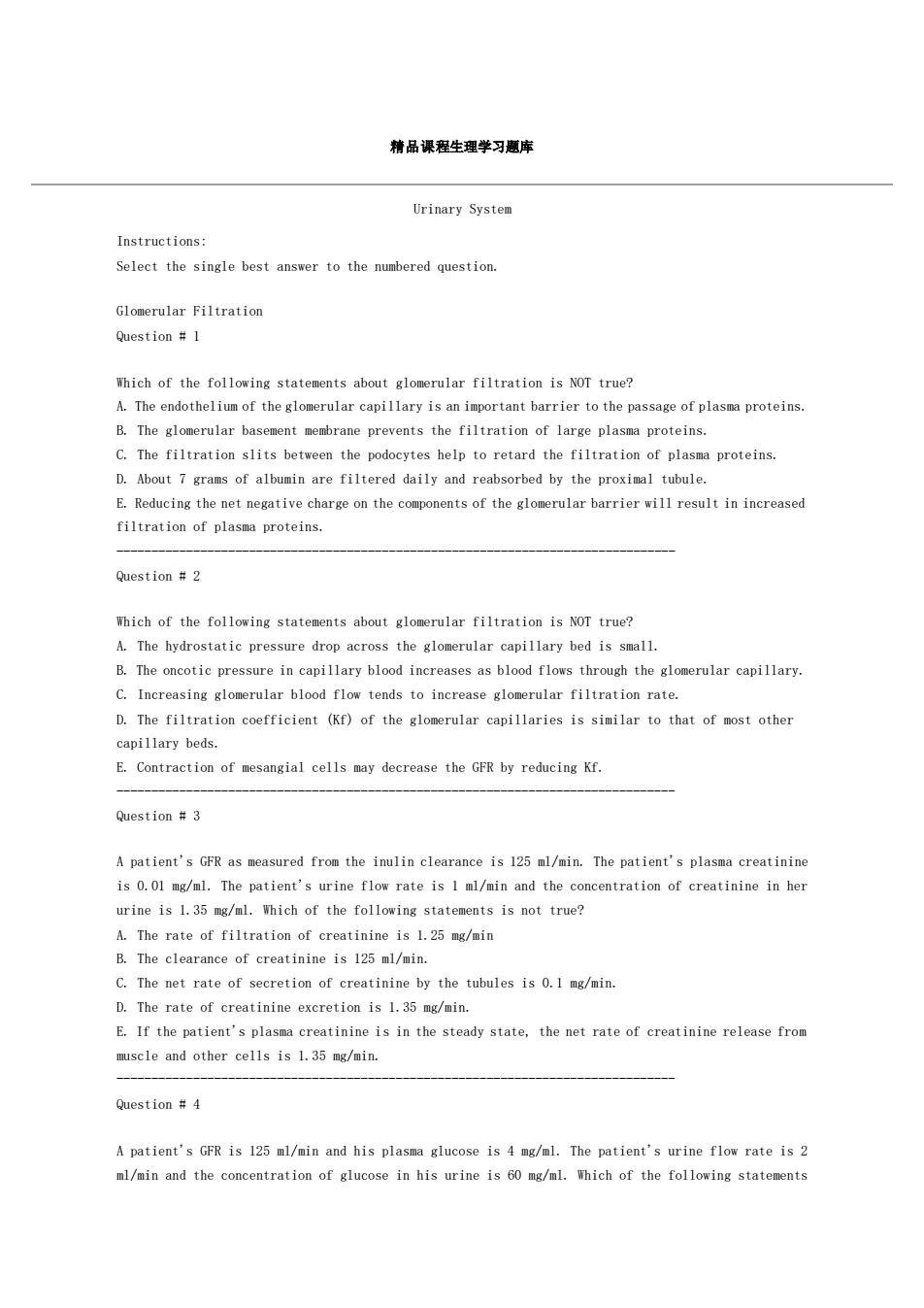
精品课程生理学习题库 Urinary Systen Instructions: Select the single best answer to the numbered question. Glomerular Filtration Question 1 Which of the following statements about glorular filtration is NOT true? er to the passage of plasma proteins B.The glonerular basement membrane prevents the filtration of large plasma proteins. C.The filtration slits between the podocytes help to retard the filtration of plasma proteins. D.About 7 grams of albumin are filtered daily and reabsorbed by the proximal tubule. e.Reducing the net negative charge on the components of the glomerular barrier will result in increased filtration of plasma proteins. Question #2 Which of the following statements about glomerular filtration is NOT true? A.The hydrostatic pressure drop across the glomerular capillary bed is small. B.The oncotic pressure in capillary blood increases as blood flows through the glomerular capillary. C.Increasing gloaerular blood flo tends to increase glomerular filtration rate D.The filtration coefficient (Kf)of the glomerular capillaries is similar to that of most other capillary beds. E.Contraction of mesangial cells may decrease the GFR by reducing Kf. Question#3 Apatient'sGFR as measured fro the inulin clearance is 125 l/i The patient's plasma creatinin is 0.01 mg/ml.The patient's urine flow rate is 1 ml/min and the concentration of creatinine in her urine is 1.35 mg/ml.Which of the following statements is not true? A.The rate of filtration of creatinine is 1.25 mg/min B.The clearance of creatinine is 125 ml/nin. C.The net rate of secretion of creatinine by the tubules is 0.1 mg/min. D.The rate of creatinine excretion is 1.35 mg/min. E.If the patient's plasma creatinine is in the steady state,the net rate of creatinine release from muscle and other cells is 1.35 ng/min. A patient's GFR is 125 al/min and his plasma glucose is 4 mg/ml.The patient's urine flow rate is 2 ml/min and the concentration of glucose in his urine is 60 mg/ml.Which of the following statements
精品课程生理学习题库 Urinary System Instructions: Select the single best answer to the numbered question. Glomerular Filtration Question # 1 Which of the following statements about glomerular filtration is NOT true? A. The endothelium of the glomerular capillary is an important barrier to the passage of plasma proteins. B. The glomerular basement membrane prevents the filtration of large plasma proteins. C. The filtration slits between the podocytes help to retard the filtration of plasma proteins. D. About 7 grams of albumin are filtered daily and reabsorbed by the proximal tubule. E. Reducing the net negative charge on the components of the glomerular barrier will result in increased filtration of plasma proteins. -------------------------------------------------------------------------------- Question # 2 Which of the following statements about glomerular filtration is NOT true? A. The hydrostatic pressure drop across the glomerular capillary bed is small. B. The oncotic pressure in capillary blood increases as blood flows through the glomerular capillary. C. Increasing glomerular blood flow tends to increase glomerular filtration rate. D. The filtration coefficient (Kf) of the glomerular capillaries is similar to that of most other capillary beds. E. Contraction of mesangial cells may decrease the GFR by reducing Kf. -------------------------------------------------------------------------------- Question # 3 A patient's GFR as measured from the inulin clearance is 125 ml/min. The patient's plasma creatinine is 0.01 mg/ml. The patient's urine flow rate is 1 ml/min and the concentration of creatinine in her urine is 1.35 mg/ml. Which of the following statements is not true? A. The rate of filtration of creatinine is 1.25 mg/min B. The clearance of creatinine is 125 ml/min. C. The net rate of secretion of creatinine by the tubules is 0.1 mg/min. D. The rate of creatinine excretion is 1.35 mg/min. E. If the patient's plasma creatinine is in the steady state, the net rate of creatinine release from muscle and other cells is 1.35 mg/min. -------------------------------------------------------------------------------- Question # 4 A patient's GFR is 125 ml/min and his plasma glucose is 4 mg/ml. The patient's urine flow rate is 2 ml/min and the concentration of glucose in his urine is 60 mg/ml. Which of the following statements
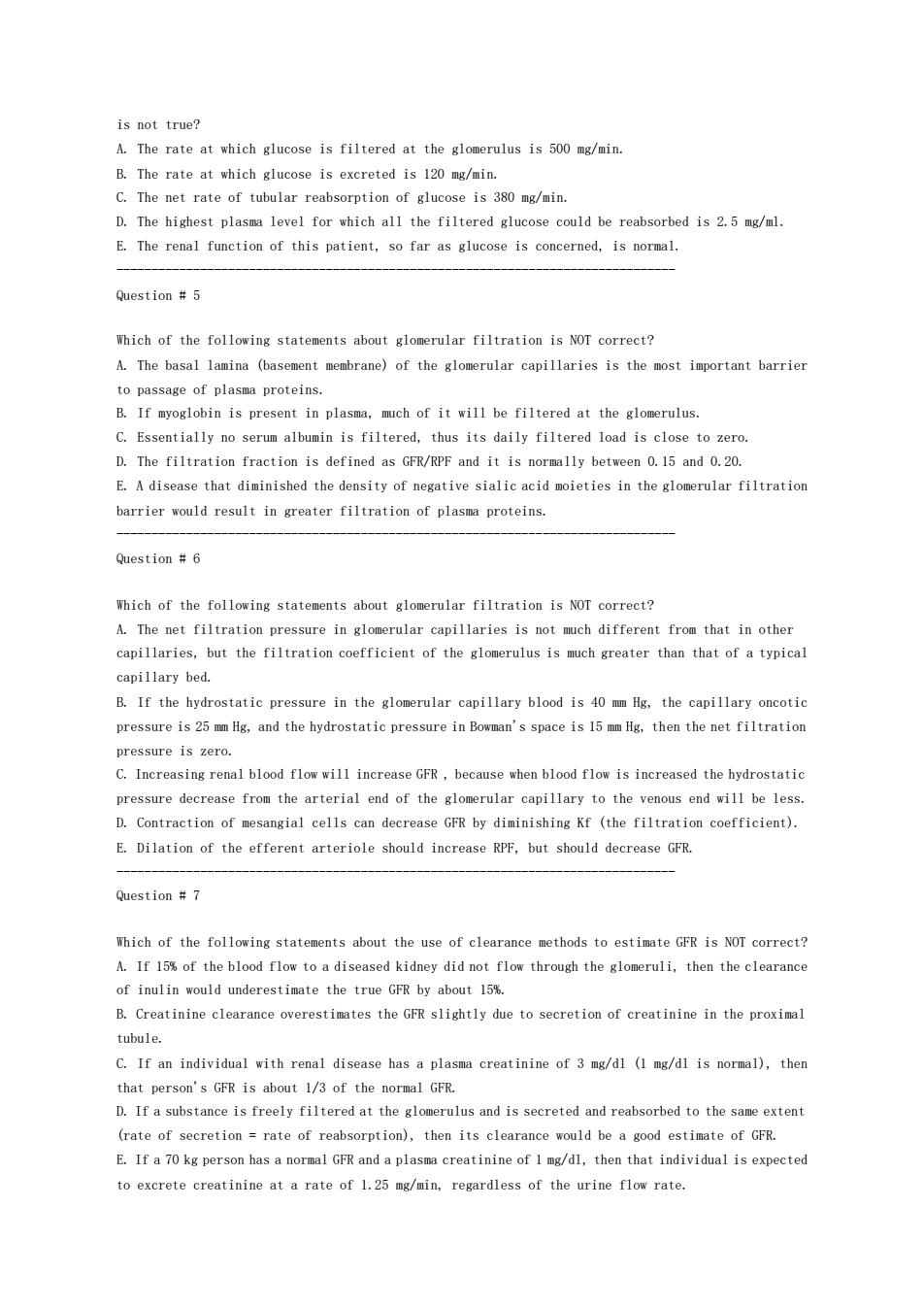
is nat true? A The rate at which glucose is filtered at the glomerulus is 500ng/min B.The rate at which glucose is excreted is 120 mg/min. C.The net rate of tubular reabsorption of glucose is 380 mg/min. D.The highest plasma level for which all the filtered glucose could be reabsorbed is 2.5 ag/ml. E.The renal function of this patient,so far as glucose is concerned,is nornal. Question #5 Which of the following statements about glomerular filtration is NOT correct? A.The basal lamina (basement membrane)of the glonerular capillaries is the nost important barrier to passage of plasna proteins. B.If myoglobin is present in plasaa.much of it will be filtered at the glomerulus. The filtration fraction is defined as GFR/RPF and it is normlly between 0.15 and 0.20 E.A disease that diminished the density of negative sialic acid moieties in the glomerular filtration barrier would result in greater filtration of plasna proteins. Question#6 Which of the stateaents about glomerular filtration is NOT correct? A.The net filtration pressure in glomerular capillaries is not mch different from that in other capillaries,but the filtration coefficient of the glomerulus is much greater than that of a typical capillary bed. B.If the hydrostatic pressure in the glomerular capillary blood is 40 mm Hg.the capillary oncotic pressure is 25m and the hydrostatic pressure in Bowman's space is 15m Hg.then the net filtratior pressure is zero. C.Increasing renal blood flow will increase GFR,because when blood flow is increased the hydrostatic pressure decrease from the arterial end of the glonerular capillary to the venous end will be less. D.Contraction of mesangial cells can decrease GFR by diminishing Kf (the filtration coefficient). E Dilation of the efferent arteriole should increase RPF,but should decrease GFR. Question#7 Which of the following statements about the use of clearance methods to estimate GFR is NOT correct? A.If 15%of the blood flow to a diseased kidney did not flow through the glomeruli,then the clearance of inulin would underestimate the true GFR by about 15%. B.Creatinine clearance overestimtes the GFR slightly due to secretion of creatinine in the proximl C.If an individual with renal disease has a plasma creatinine of 3 mg/dl (1 ng/dl is normal),then that person's GFR is about 1/3 of the normal GFR. D.If a substance is freely filtered at the glomerulus and is secreted and reabsorbed to the same extent (rate of secretion =rate of reabsorption),then its clearance would be a good estimate of GFR. E.If a70 kg person has a norml GFR and a plas. creatinine/dl,then ha individual is expected to excrete creatinine at a rate of 1.25 mg/min.regardless of the urine flow rate
is not true? A. The rate at which glucose is filtered at the glomerulus is 500 mg/min. B. The rate at which glucose is excreted is 120 mg/min. C. The net rate of tubular reabsorption of glucose is 380 mg/min. D. The highest plasma level for which all the filtered glucose could be reabsorbed is 2.5 mg/ml. E. The renal function of this patient, so far as glucose is concerned, is normal. -------------------------------------------------------------------------------- Question # 5 Which of the following statements about glomerular filtration is NOT correct? A. The basal lamina (basement membrane) of the glomerular capillaries is the most important barrier to passage of plasma proteins. B. If myoglobin is present in plasma, much of it will be filtered at the glomerulus. C. Essentially no serum albumin is filtered, thus its daily filtered load is close to zero. D. The filtration fraction is defined as GFR/RPF and it is normally between 0.15 and 0.20. E. A disease that diminished the density of negative sialic acid moieties in the glomerular filtration barrier would result in greater filtration of plasma proteins. -------------------------------------------------------------------------------- Question # 6 Which of the following statements about glomerular filtration is NOT correct? A. The net filtration pressure in glomerular capillaries is not much different from that in other capillaries, but the filtration coefficient of the glomerulus is much greater than that of a typical capillary bed. B. If the hydrostatic pressure in the glomerular capillary blood is 40 mm Hg, the capillary oncotic pressure is 25 mm Hg, and the hydrostatic pressure in Bowman's space is 15 mm Hg, then the net filtration pressure is zero. C. Increasing renal blood flow will increase GFR , because when blood flow is increased the hydrostatic pressure decrease from the arterial end of the glomerular capillary to the venous end will be less. D. Contraction of mesangial cells can decrease GFR by diminishing Kf (the filtration coefficient). E. Dilation of the efferent arteriole should increase RPF, but should decrease GFR. -------------------------------------------------------------------------------- Question # 7 Which of the following statements about the use of clearance methods to estimate GFR is NOT correct? A. If 15% of the blood flow to a diseased kidney did not flow through the glomeruli, then the clearance of inulin would underestimate the true GFR by about 15%. B. Creatinine clearance overestimates the GFR slightly due to secretion of creatinine in the proximal tubule. C. If an individual with renal disease has a plasma creatinine of 3 mg/dl (1 mg/dl is normal), then that person's GFR is about 1/3 of the normal GFR. D. If a substance is freely filtered at the glomerulus and is secreted and reabsorbed to the same extent (rate of secretion = rate of reabsorption), then its clearance would be a good estimate of GFR. E. If a 70 kg person has a normal GFR and a plasma creatinine of 1 mg/dl, then that individual is expected to excrete creatinine at a rate of 1.25 mg/min, regardless of the urine flow rate
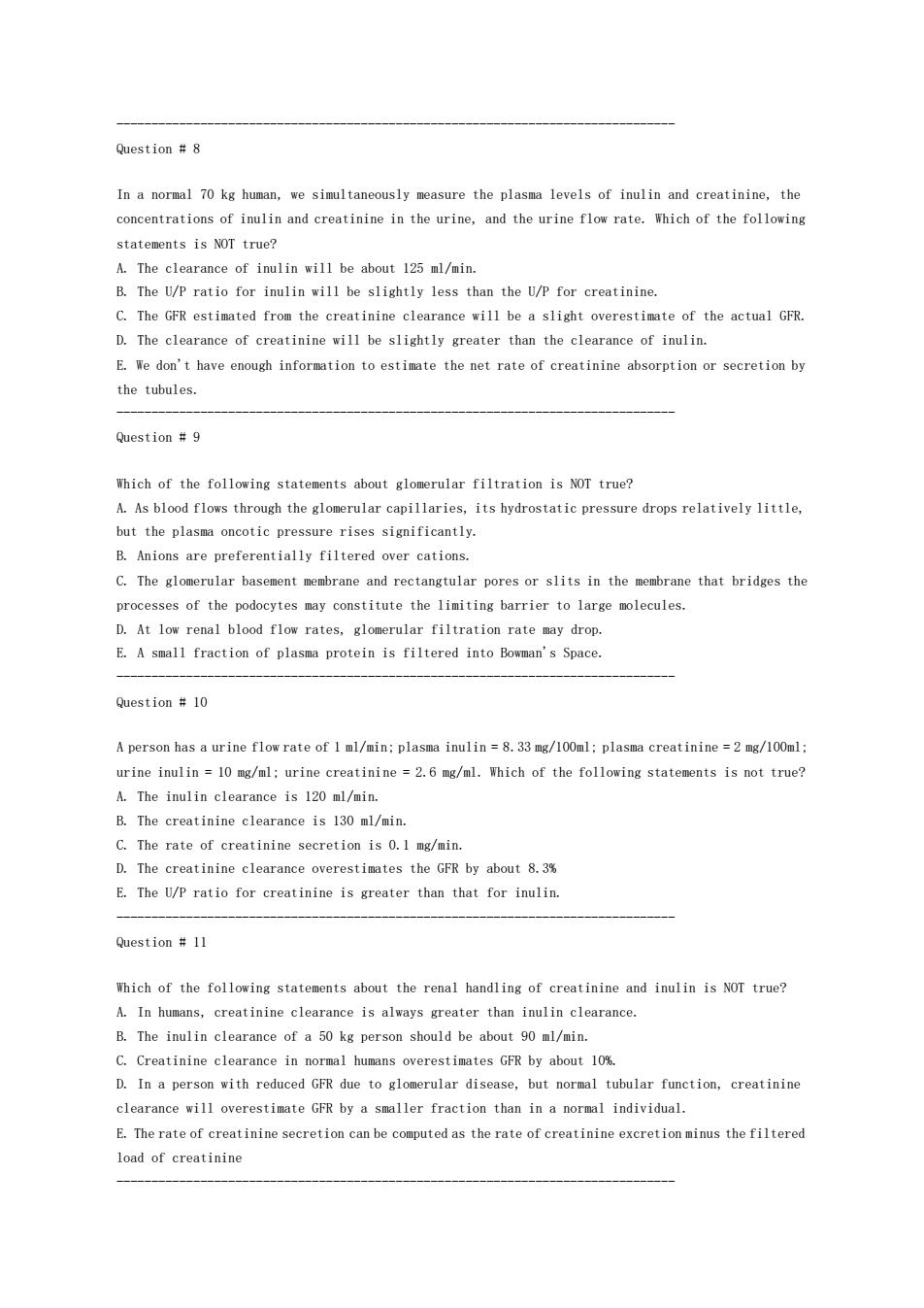
Question#8 In a normal 70 kg human,we simultaneously measure the plasma levels of inulin and creatinine,the concentrations of inulin and creatinine in the urine,and the urine flow rate.Which of the following statements is NOT true? A.The clearance of inulin will be about 125 ml/min. B.The U/P ratio for inulin will be slightly less than the U/P for creatinine. C.The GFR estimted from the creatinine clearance il be a slight overestimte of the actual GFR. D.The clearance of creatininevill be slightly greate than the clearance of inulin E.We don't have enough information to estimate the net rate of creatinine absorption or secretion by the tubules. Question#9 hich of the following statements about glomerular filtration is MOT true? A As blood flows through the gloerlar capillaries,its hydrostatic pressure drops relatively little out the plasma oncotic pressure rises significantly. B.Anions are preferentially filtered over cations. C.The glonerular basement membrane and rectangtular pores or slits in the membrane that bridges the esses of the podocytes may constitute the limiting barrier to large lecules E.A small fraction of plasma protein is filtered into Bowman's Space. Question #10 A person has a urine flow rate of 1 ml/nin:plasma inulin =8.33 mg/100ml:plasma creatinine =2 mg/100ml rine inulin-10g/:urine creatinine2.6ng/ml.Which of the following statements is not true? The imlin clearance B.The creatinine clearance is 130 ml/min. C.The rate of creatinine secretion is 0.I mg/min. D.The creatinine clearance overestinates the GFR by about 8.3% E The U/P ratio for creatinine is greater than that for inulin. Question#11 Which of the following statements about the renal handling of creatinine and inulin is NOT true? A.In humans,creatinine clearance is always greater than inulin clearance. B.The inulin clearance of a 50 kg person should be about 90 ml/min. C.Creatinine clearance in D.Ina person with reduced GFR due togloerular disease,but nor tubular function,creatinine clearance will overestimate GFR by a smaller fraction than in a normal individual. E The rate of creatinine secretion can be computed as the rate of creatinine excretion minus the filtered load of creatinine
-------------------------------------------------------------------------------- Question # 8 In a normal 70 kg human, we simultaneously measure the plasma levels of inulin and creatinine, the concentrations of inulin and creatinine in the urine, and the urine flow rate. Which of the following statements is NOT true? A. The clearance of inulin will be about 125 ml/min. B. The U/P ratio for inulin will be slightly less than the U/P for creatinine. C. The GFR estimated from the creatinine clearance will be a slight overestimate of the actual GFR. D. The clearance of creatinine will be slightly greater than the clearance of inulin. E. We don't have enough information to estimate the net rate of creatinine absorption or secretion by the tubules. -------------------------------------------------------------------------------- Question # 9 Which of the following statements about glomerular filtration is NOT true? A. As blood flows through the glomerular capillaries, its hydrostatic pressure drops relatively little, but the plasma oncotic pressure rises significantly. B. Anions are preferentially filtered over cations. C. The glomerular basement membrane and rectangtular pores or slits in the membrane that bridges the processes of the podocytes may constitute the limiting barrier to large molecules. D. At low renal blood flow rates, glomerular filtration rate may drop. E. A small fraction of plasma protein is filtered into Bowman's Space. -------------------------------------------------------------------------------- Question # 10 A person has a urine flow rate of 1 ml/min; plasma inulin = 8.33 mg/100ml; plasma creatinine = 2 mg/100ml; urine inulin = 10 mg/ml; urine creatinine = 2.6 mg/ml. Which of the following statements is not true? A. The inulin clearance is 120 ml/min. B. The creatinine clearance is 130 ml/min. C. The rate of creatinine secretion is 0.1 mg/min. D. The creatinine clearance overestimates the GFR by about 8.3% E. The U/P ratio for creatinine is greater than that for inulin. -------------------------------------------------------------------------------- Question # 11 Which of the following statements about the renal handling of creatinine and inulin is NOT true? A. In humans, creatinine clearance is always greater than inulin clearance. B. The inulin clearance of a 50 kg person should be about 90 ml/min. C. Creatinine clearance in normal humans overestimates GFR by about 10%. D. In a person with reduced GFR due to glomerular disease, but normal tubular function, creatinine clearance will overestimate GFR by a smaller fraction than in a normal individual. E. The rate of creatinine secretion can be computed as the rate of creatinine excretion minus the filtered load of creatinine --------------------------------------------------------------------------------
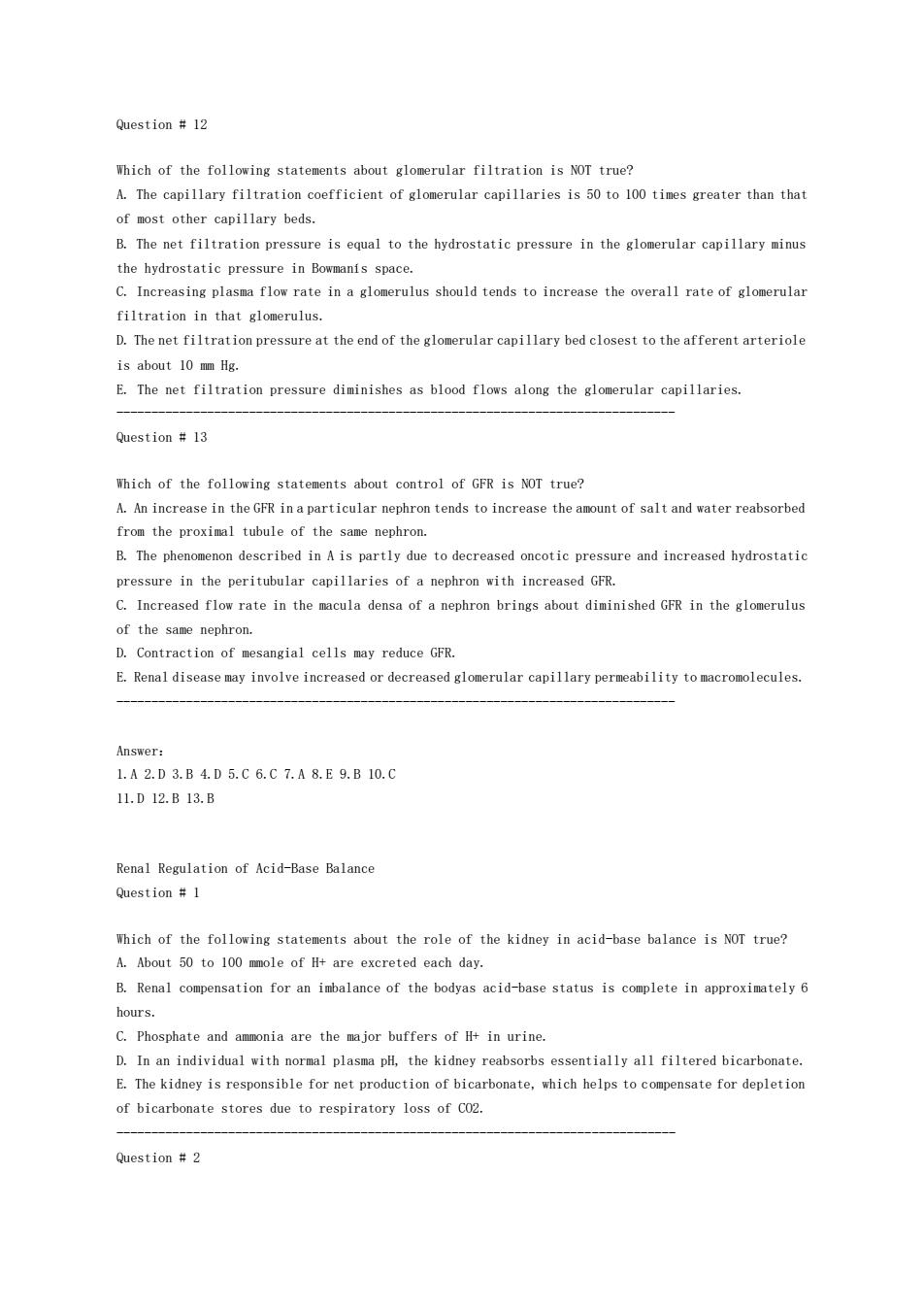
Question#12 Which of the following statenents about glomerular filtration is Not true? A.The capillary filtration coefficient of capillaries is50 greater than tha of most other capillary beds. B.The net filtration pressure is equal to the hydrostatic pressure in the glomerular capillary minus the hydrostatic pressure in Bowranis space. C.Increasing plasma flow rate in a glomerulus should tends to increase the overall rate of glomerular filtration in that glomerulus. D.The net filtration pressure at the end of the glomerular capillary bed closest to the afferent arteriole is about 10 am Hg. E.The net filtration pressure diminishes as blood flows along the glomerular capillaries. Question #13 ich of the following stateents about control of GFR is NOT true? A.An increase in the GFR in a particular nephron tends to increase the amount of salt and water reabsorbed from the proximal tubule of the sane nephron. B.The phenonenon described in A is partly due to decreased oncotic pressure and increased hydrostatic pressure in the peritubular capillaries of a nephron ith increased GFR. 、 sed flo rate in the macula densa of a nephron brings about diainished GFR in the gloerulus of the same nephron. D.Contraction of mesangial cells may reduce GFR. E.Renal disease may involve increased or decreased glomerular capillary permeability to macromolecules. Answer: LA2.D3.B4D5.C6.C7.A8.E9.B10.C 11.D12.B13.B Renal Regulation of Acid-Base Balance Question Which of the olloing stateaents about therole of the kidney in acid-base balance is NOT true? A.About 50 to 100 mmole of H+are excreted each day. B.Renal compensation for an imbalance of the bodyas acid-base status is complete in approximately 6 hours. C.Phosphate and ammonia are the mjor buffers of H+in urine. In an plasma the kidney reabsorbs essentially all filtered bicabonate. E.The kidney is responsible for net production of bicarbonate,which helps to compensate for depletion of bicarbonate stores due to respiratory loss of 2. Question#2
Question # 12 Which of the following statements about glomerular filtration is NOT true? A. The capillary filtration coefficient of glomerular capillaries is 50 to 100 times greater than that of most other capillary beds. B. The net filtration pressure is equal to the hydrostatic pressure in the glomerular capillary minus the hydrostatic pressure in Bowmanís space. C. Increasing plasma flow rate in a glomerulus should tends to increase the overall rate of glomerular filtration in that glomerulus. D. The net filtration pressure at the end of the glomerular capillary bed closest to the afferent arteriole is about 10 mm Hg. E. The net filtration pressure diminishes as blood flows along the glomerular capillaries. -------------------------------------------------------------------------------- Question # 13 Which of the following statements about control of GFR is NOT true? A. An increase in the GFR in a particular nephron tends to increase the amount of salt and water reabsorbed from the proximal tubule of the same nephron. B. The phenomenon described in A is partly due to decreased oncotic pressure and increased hydrostatic pressure in the peritubular capillaries of a nephron with increased GFR. C. Increased flow rate in the macula densa of a nephron brings about diminished GFR in the glomerulus of the same nephron. D. Contraction of mesangial cells may reduce GFR. E. Renal disease may involve increased or decreased glomerular capillary permeability to macromolecules. -------------------------------------------------------------------------------- Answer: 1.A 2.D 3.B 4.D 5.C 6.C 7.A 8.E 9.B 10.C 11.D 12.B 13.B Renal Regulation of Acid-Base Balance Question # 1 Which of the following statements about the role of the kidney in acid-base balance is NOT true? A. About 50 to 100 mmole of H+ are excreted each day. B. Renal compensation for an imbalance of the bodyas acid-base status is complete in approximately 6 hours. C. Phosphate and ammonia are the major buffers of H+ in urine. D. In an individual with normal plasma pH, the kidney reabsorbs essentially all filtered bicarbonate. E. The kidney is responsible for net production of bicarbonate, which helps to compensate for depletion of bicarbonate stores due to respiratory loss of CO2. -------------------------------------------------------------------------------- Question # 2
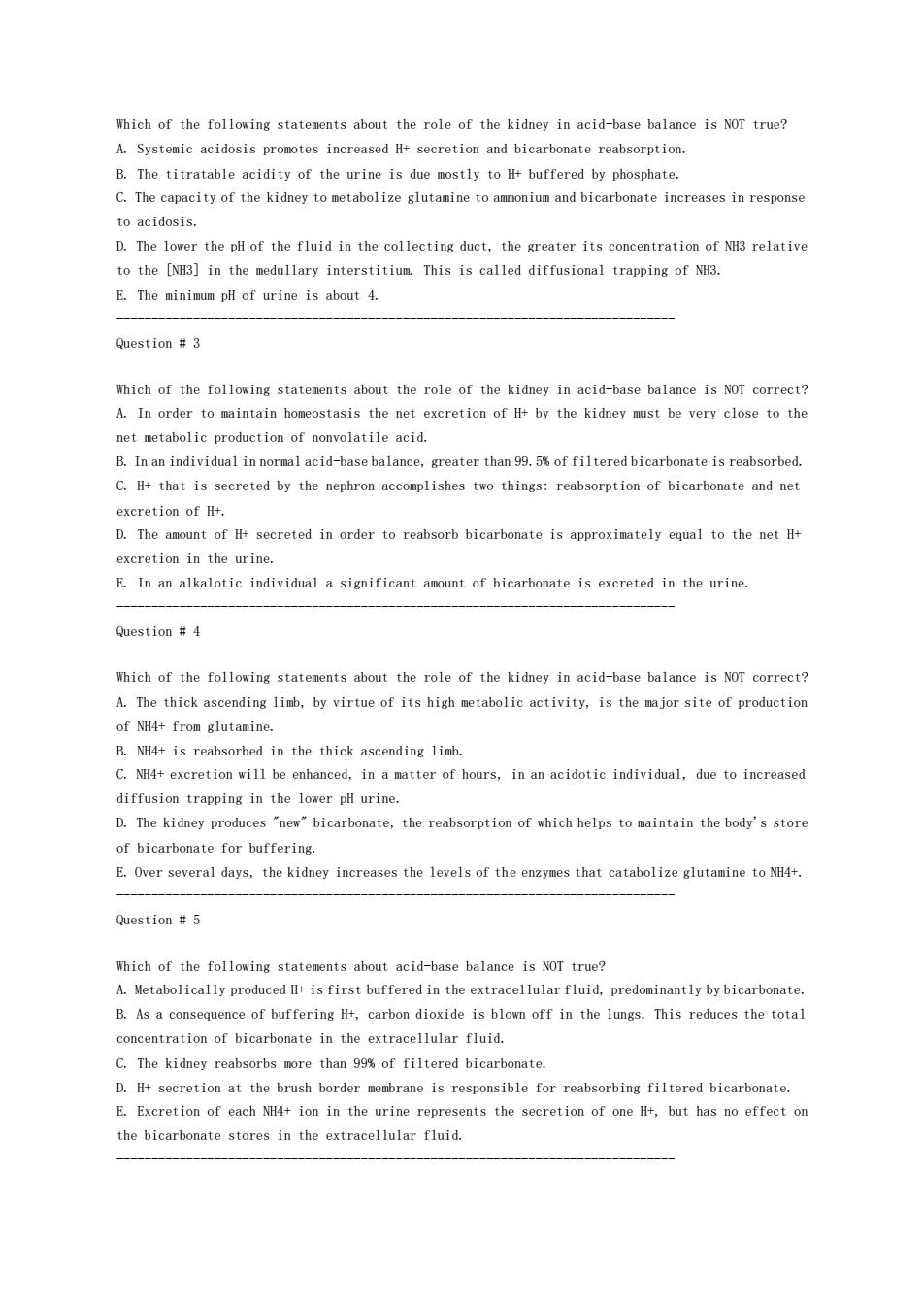
Which of the following statements about the role of the kidney in acid-base balance is NOT true? A Systemic acidosis promotes increased Ht secretion and bicarbonate reabsorption. B.The titratable acidity of the ine isde by phosphat C.The capacity of the kidney to metabolize glutamine to amoniun and bicarbonate increases in response to acidosis. D.The lower the pH of the fluid in the collecting duct,the greater its concentration of NH3 relative to the [NH3]in the medullary interstitium.This is called diffusional trapping of NH3. E The ainimum pH of urine is about 4. Question#3 Which of the following statements about the role of the kidney in acid-base balance is NOT correct? A In order to naintain homeostasis the net excretion of H+by the kidney must be very close to the net netabolic production of nonvolatile acid. B.Inan individual innormalacid-base balanc greater than9of ftered bicarbonate is reabsorbed. C.that is secreted by the nephron accomplishes two things:reabsorption of bicarbonate and net excretion of H+. D.The amount of H+secreted in order to reabsorb bicarbonate is approximately equal to the net H+ excretion in the urine E.In an alkalotic individual a significant anount of bicarbonate is excreted in the urine Question Which of the following statements about the role of the kidney in acid-base balance is NOT correct? A.The thick ascending lirb,by virtue of its high metabolic activity,is the ma jor site of production of NH4+from glutamine. B.is reab a the thic ding limb C.N4+excretion will be enhanced,in a matter of hours,in an acidotic individual,due to increased diffusion trapping in the lower pH urine. D.The kidney produces "new"bicarbonate,the reabsorption of which helps to maintain the body's store of bicarbonate for buffering. Over several days.the kidney increases the levels of the enyes that Question年5 Which of the following statenents about acid-base balance is NOT true? A.Metabolically produced H+is first buffered in the extracellular fluid,predominantly by bicarbonate B.As a consequence of buffering carbon dioxide is blom off in the lungs.This reduces the total entration of bicarbonate in the C.The kidney reabsorbs more than 99%of filtered bicarbonate. D.H+secretion at the brush border membrane is responsible for reabsorbing filtered bicarbonate. E.Excretion of each NH4+ion in the urine represents the secretion of one H+,but has no effect on the bicarbonate stores in the extracellular fluid
Which of the following statements about the role of the kidney in acid-base balance is NOT true? A. Systemic acidosis promotes increased H+ secretion and bicarbonate reabsorption. B. The titratable acidity of the urine is due mostly to H+ buffered by phosphate. C. The capacity of the kidney to metabolize glutamine to ammonium and bicarbonate increases in response to acidosis. D. The lower the pH of the fluid in the collecting duct, the greater its concentration of NH3 relative to the [NH3] in the medullary interstitium. This is called diffusional trapping of NH3. E. The minimum pH of urine is about 4. -------------------------------------------------------------------------------- Question # 3 Which of the following statements about the role of the kidney in acid-base balance is NOT correct? A. In order to maintain homeostasis the net excretion of H+ by the kidney must be very close to the net metabolic production of nonvolatile acid. B. In an individual in normal acid-base balance, greater than 99.5% of filtered bicarbonate is reabsorbed. C. H+ that is secreted by the nephron accomplishes two things: reabsorption of bicarbonate and net excretion of H+. D. The amount of H+ secreted in order to reabsorb bicarbonate is approximately equal to the net H+ excretion in the urine. E. In an alkalotic individual a significant amount of bicarbonate is excreted in the urine. -------------------------------------------------------------------------------- Question # 4 Which of the following statements about the role of the kidney in acid-base balance is NOT correct? A. The thick ascending limb, by virtue of its high metabolic activity, is the major site of production of NH4+ from glutamine. B. NH4+ is reabsorbed in the thick ascending limb. C. NH4+ excretion will be enhanced, in a matter of hours, in an acidotic individual, due to increased diffusion trapping in the lower pH urine. D. The kidney produces "new" bicarbonate, the reabsorption of which helps to maintain the body's store of bicarbonate for buffering. E. Over several days, the kidney increases the levels of the enzymes that catabolize glutamine to NH4+. -------------------------------------------------------------------------------- Question # 5 Which of the following statements about acid-base balance is NOT true? A. Metabolically produced H+ is first buffered in the extracellular fluid, predominantly by bicarbonate. B. As a consequence of buffering H+, carbon dioxide is blown off in the lungs. This reduces the total concentration of bicarbonate in the extracellular fluid. C. The kidney reabsorbs more than 99% of filtered bicarbonate. D. H+ secretion at the brush border membrane is responsible for reabsorbing filtered bicarbonate. E. Excretion of each NH4+ ion in the urine represents the secretion of one H+, but has no effect on the bicarbonate stores in the extracellular fluid. --------------------------------------------------------------------------------